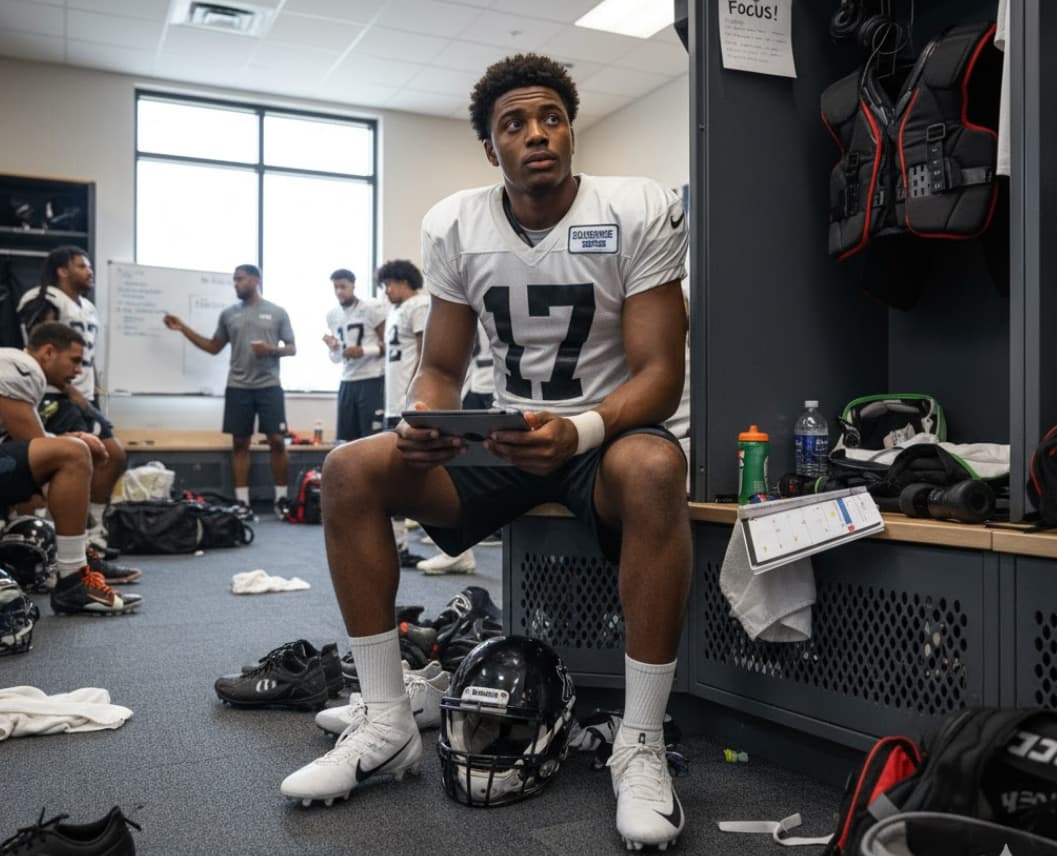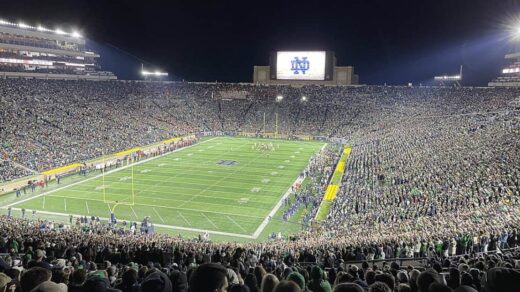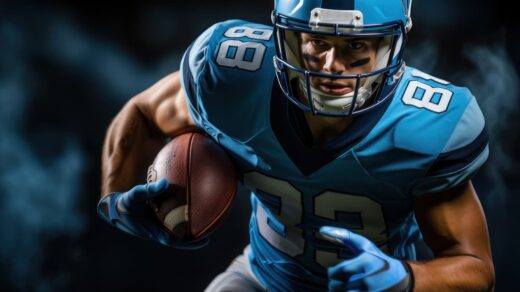ADHD doesn’t stop you from reaching the NFL. In fact, for some players, it might actually help them get there.
When fans search “NFL players with adhd reddit” to learn more about these athletes, they’re looking for hope, inspiration, and proof that neurological differences don’t define their limits.
They find stories of Hall of Famers, Pro Bowlers, and Super Bowl champions who’ve turned their ADHD challenges into competitive advantages.
Many NFL players with ADHD have proven that attention challenges don’t prevent success—they can actually drive it.
Through structure, discipline, and an intense passion for football, these athletes have shown how ADHD can be managed and even transformed into a source of strength.
From legendary quarterbacks like Terry Bradshaw to modern defensive stars like Marcell Dareus, these players exemplify resilience.
They’ve proven that success in the NFL isn’t about avoiding obstacles but conquering them.
NFL Players with ADHD

Let’s explore the real stories of NFL players with ADHD who’ve made it to the top of professional football.
Did You Know? Current Hispanic NFL Players
What ADHD Looks Like in Real Football Life?
ADHD – Attention Deficit Hyperactivity Disorder—affects how the brain processes focus, impulses, and energy. For athletes, this creates unique challenges and unexpected advantages.
- The Challenges:
Difficulty focusing during long film sessions or team meetings can make learning playbooks harder. Hyperactivity makes sitting still nearly impossible, especially during classroom-style coaching sessions. Emotional intensity can lead to frustration when things don’t go right on the field. Impulsivity might cause penalties or poor split-second decisions.
- The Advantages:
But here’s what many people miss—ADHD also brings incredible strengths to football.
Fast reactions and quick decision-making help players read plays instantly. High energy levels fuel the motor that coaches love in defensive players. Strong passion creates the competitive fire that drives champions. Creative thinking allows players to see plays developing differently than others.
The key is learning to channel these traits productively.
This pattern appears across all sports. Famous athletes with ADHD have succeeded in virtually every competition.
NBA players with ADHD use their high energy in fast-paced basketball environments.
Soccer players with ADHD thrive in the constant movement and strategic complexity of the world’s most popular sport.
College athletes with ADHD receive accommodations that help them balance academics with athletics.
Even Premier League football players with ADHD compete at England’s highest level.
The common thread? These athletes found environments where their intensity, passion, and unique way of processing information became assets rather than liabilities.
Did You Know? Asian NFL Players
Terry Bradshaw: The Hall of Fame Quarterback Who Played With Undiagnosed ADHD
- Career Stats: 14 Seasons | 27,989 Passing Yards | 212 Touchdowns | 4× Super Bowl Champion
- His Message: “I couldn’t focus, I couldn’t sit still… but football gave me structure.”
Terry Bradshaw is one of the most famous NFL players with ADHD, though he didn’t know it during his playing days.
The Pittsburgh Steelers legend won four Super Bowls in the 1970s, became a Hall of Famer, and built a career as a beloved broadcaster. But throughout his playing days, Bradshaw struggled with something he couldn’t name or understand.
According to the Edge Foundation, Bradshaw openly discussed his lifelong battle with ADHD and depression after retirement. Both conditions were diagnosed years after his final game, helping him finally understand the difficulties he’d faced throughout his career.
Imagine trying to run complex offensive plays, read defenses pre-snap, and lead a championship team while your brain constantly pulls you in different directions. Bradshaw’s intense energy and competitiveness—the very traits that made him a fierce leader—were symptoms of undiagnosed ADHD working through him.
Football became his salvation. The structure of practice schedules, the intensity of game day, the singular focus required when dropping back to pass—these elements gave his restless mind something concrete to lock onto.
Today, Bradshaw is a powerful advocate for ADHD and mental health awareness in sports. He speaks openly about his struggles, helping younger athletes understand they’re not alone. His message resonates: struggling doesn’t make you weak. Getting help and understanding yourself makes you strong.
Bradshaw proved you can reach the absolute pinnacle of NFL success even with undiagnosed ADHD. Imagine what today’s athletes can accomplish with proper support and understanding.
Did You Know? Asian NFL Players
Marcell Dareus: The Defensive Force Who Found Control Through Football
- Career Stats: 121 Games | 365 Tackles | 37.5 Sacks | 2× Pro Bowl Selection
- His Words: “One of the big things about ADHD is learning how to control it. Football helped me do that.”
Marcell Dareus brought chaos to opposing offenses, but growing up, ADHD brought chaos to his own life.
This physically dominant defensive tackle struggled tremendously in school. His hyperactivity made sitting through classes feel impossible. Academics became torture when his brain desperately wanted to move, run, and hit something.
But on the football field, everything changed.
In an NFL interview, Dareus revealed how his ADHD diagnosis helped him understand himself better.
He wasn’t lazy or lacking discipline – his brain simply operated differently. Once he grasped that concept, he could develop strategies to channel his energy productively.
Football became his outlet for focus and control. The intensity of defensive line play – exploding off the snap, reading offensive formations, pursuing ball carriers with relentless motor – required exactly the kind of focused aggression that came naturally to his ADHD brain.
Dareus’s ability to channel ADHD energy into defensive dominance helped him become a first-round draft pick and earn two Pro Bowl selections.
His high-energy playing style, the trait that made academics difficult, became his greatest asset in the NFL.
His message to young athletes resonates powerfully: what others see as hyperactivity might actually be fuel for greatness on the field.
The challenge isn’t having ADHD—it’s finding the right environment where your brain’s natural wiring becomes an advantage.
Did You Know? Greatest NFL Quarterbacks
Garett Bolles: From Troubled Youth to Elite NFL Offensive Tackle
- Career Stats: 120+ Career Starts | 1st-Round Draft Pick (2017) | All-Pro Level Player
- His Words: “I struggled with ADHD, but I learned discipline — and that changed my life.”
Garett Bolles’s story is the most dramatic transformation on this list.
As reported by AP News and the NFLPA features, Bolles faced severe challenges during his youth. He was expelled from multiple schools due to behavioral issues directly linked to his ADHD.
Teachers saw a troublemaker. School administrators saw a problem student. Bolles himself felt lost, unable to control impulses or focus long enough to succeed.
His childhood was harsh. The behavioral issues stemming from unmanaged ADHD led to suspensions, expulsions, and a path that could have ended tragically.
Many kids in similar situations never find their way out.
But Bolles found mentorship, faith, and the structure of football.
Learning to play offensive tackle at a high level requires incredible discipline – precise footwork, memorizing complex blocking schemes, and studying defensive tendencies for hours.
For someone with ADHD, this level of structure can actually be therapeutic when approached correctly.
Bolles learned discipline. That discipline changed everything.
The Denver Broncos selected him in the first round of the 2017 NFL Draft.
He’s since started over 120 games and developed into one of the league’s most consistent offensive tackles, earning recognition at an All-Pro level.
Bolles speaks openly about his journey, hoping to reach young athletes facing similar struggles.
His message is clear: ADHD and difficult circumstances don’t determine your future. Discipline, support systems, and refusing to quit determine your future.
His transformation from expelled student to first-round NFL draft pick shows that no matter how dark things look, the right support and personal determination can change everything.
J.T. Thomas III: Diagnosed at 24 and Still Succeeding in the NFL
- Career Stats: 159 Total Tackles | 4 Forced Fumbles | 2 Interceptions
- His Words: “I didn’t know why I couldn’t sit still or zone out sometimes. Once I knew it was ADHD, I worked around it.”
J.T. Thomas III had already made it to the NFL when he finally got answers.
According to Business Insider, Thomas was diagnosed with ADHD at age 24 years after high school, college, and even after beginning his professional football career.
Imagine going through your entire athletic journey without understanding why certain things felt so difficult.
Film study sessions were torture. Sitting through team meetings felt impossible. Zone-out moments happened at random times, making it hard to absorb coaching points.
Thomas didn’t understand why these challenges affected him when teammates seemed fine.
The diagnosis was actually a relief.
Suddenly, Thomas understood himself better. He wasn’t lacking intelligence or dedication—his brain processed information differently.
Armed with that knowledge, he could develop coping strategies that worked with his ADHD rather than against it.
Thomas worked with team doctors and mental health professionals to create personalized routines. He broke film study into shorter, more focused sessions.
He took notes during meetings to keep his hands busy and mind engaged. He found ways to make learning playbooks work for his brain’s natural wiring.
His journey demonstrates something crucial for young athletes: even undiagnosed ADHD doesn’t prevent NFL success. But proper diagnosis, understanding, and support can take performance from good to great.
Thomas also highlights why conversations about NFL players with adhd medication and treatment options matter.
Getting the right support – whether that’s therapy, medication, accommodations, or coaching adjustments—can be genuinely life-changing for athletes with ADHD.
Quinn Pitcock: The Advocate Who Found Purpose After Football
- Career Stats: Former Ohio State Standout | Brief NFL Career
- His Message: “I wanted to help others know it’s okay to talk about ADHD and depression.”
Quinn Pitcock’s NFL career was shorter than others on this list, but his impact on mental health awareness has been profound.
Pitcock was a talented defensive tackle at Ohio State who reached the NFL with the Indianapolis Colts.
But as ESPN reported, the transition from college to professional football amplified his struggles with ADHD combined with anxiety and depression.
The structured environment of college—classes, study halls, practice schedules, and team activities—had provided routines that helped manage his ADHD symptoms.
When that structure changed in the NFL, when life became more independent and isolated, Pitcock struggled to adapt.
The combination of ADHD, anxiety, and depression created overwhelming challenges. After stepping away from football, Pitcock made a courageous decision: he spoke publicly about his mental health struggles.
His advocacy work focuses on helping athletes understand that asking for help isn’t weakness—it’s wisdom.
Pitcock’s willingness to be vulnerable has opened doors for more honest conversations about mental health in locker rooms across professional and college football.
He’s particularly passionate about helping athletes transition to life after sports.
The loss of structure when a playing career ends can be devastating for athletes with ADHD who relied on that routine for stability.
Today, Pitcock’s legacy isn’t measured in tackles or sacks. It’s measured in the athletes he’s helped through his honesty and the stigma he’s helped break down around ADHD and depression in sports.
Additional Players: More NFL Stars with ADHD
- Peyton Barber – Running Back, Tampa Bay Buccaneers / Washington
- Career Stats: 2,457 Rushing Yards | 21 Touchdowns
Peyton Barber was diagnosed with both ADHD and dyslexia in middle school. According to Auburn University Athletics, he used academic accommodations and mental health resources to balance school and sports successfully.
His message resonates with struggling students: “Having ADHD doesn’t make you less. It means you learn differently—and that’s okay.”
Barber’s story demonstrates how structured routines and determination can turn ADHD into a source of strength rather than a barrier. His success with Tampa Bay and Washington shows that proper support systems help athletes thrive at the highest levels.
- Virgil Green – Tight End, Denver Broncos / Los Angeles Chargers
- Career Stats: Over 120 Receptions | Super Bowl 50 Champion
Virgil Green is known for his discipline and focus throughout a successful NFL career. According to the Denver Post reports, Green reportedly managed his ADHD through prescribed medication and structured routines.
His commitment to mental health helped him maintain consistency across multiple seasons. Green’s words capture his approach: “Structure and support are what keep you sharp when you live with ADHD.”
For athletes who benefit from medication, Green represents how proper treatment allows players to compete at championship levels. His Super Bowl 50 victory with Denver proves that managing ADHD effectively doesn’t limit your ceiling in professional football.
ADHD in Other Sports: How Different Games Handle It
ADHD affects athletes across every sport, but each game presents unique challenges and advantages:
- NBA Players with ADHD
Basketball’s fast pace and constant motion actually suit many ADHD brains well. The game rarely stops, players are constantly moving, and split-second decisions matter more than long strategic planning. Several NBA players with ADHD have reached All-Star status, showing that the sport’s intensity can channel ADHD energy productively.
- Soccer Players with ADHD
Soccer requires incredible endurance and constant awareness over 90 minutes. Soccer players with ADHD often excel because the game provides continuous engagement—no long periods of standing around. The strategic complexity keeps minds active while bodies stay in motion.
- Premier League Football Players with ADHD
England’s top soccer division features premier league football players with ADHD competing at the highest international levels. The sport’s global reach and demanding schedules require excellent management strategies, but many players thrive with proper support.
- College Athletes with ADHD
College athletes with ADHD receive academic accommodations like extended test time, note-taking assistance, and flexible tutoring schedules. These supports allow them to succeed academically while excelling athletically, preparing them for professional careers.
The pattern across all sports is clear: ADHD doesn’t prevent elite performance. The right environment, proper support, and personal determination allow athletes with ADHD to compete with anyone.
How NFL Teams Support Players with ADHD?
Modern NFL teams have developed sophisticated support systems for players with ADHD:
- Mental Health Professionals
Every NFL team now employs sports psychologists and mental health counselors. These professionals help players develop coping strategies, manage medications if needed, and address challenges before they become crises.
- Structured Practice Schedules
Teams create consistent daily routines that provide the structure many ADHD athletes need. Predictable schedules help players manage their symptoms through routine rather than constantly adapting to chaos.
- Film Study Tools
Modern technology allows players to break film study into shorter, more digestible segments. Apps and tablets let players review plays in quick bursts rather than sitting through hours of continuous film—a game-changer for players who struggle with sustained attention.
- Coaching Communication
Progressive coaches learn to communicate differently with ADHD players. Some players absorb information better through visual demonstrations than verbal explanations. Others need concepts repeated multiple times or written down. Good coaches adapt their teaching methods to each player’s learning style.
- Medication Rules and Support
The NFL allows prescribed ADHD medication under proper medical supervision. Players work with team doctors to find treatments that manage symptoms without violating league policies. This medical support ensures athletes can compete on a level playing field while managing their condition.
These support systems represent major progress in how professional football views neurodiversity. Twenty years ago, players with ADHD often struggled silently. Today, teams recognize that supporting these athletes makes everyone better.
Why These Players Inspire Millions?
Stories of NFL players with ADHD resonate far beyond football stadiums.
Parents of children with ADHD find hope in these examples.
When your kid struggles in school, feels different from classmates, or faces constant criticism for hyperactivity, seeing Terry Bradshaw’s four Super Bowl rings or Garett Bolles’s first-round draft pick proves that ADHD doesn’t limit potential.
Young athletes with ADHD discover role models who look like them. They see that professional success is possible, that their challenges don’t define them, and that the traits making school difficult might actually help in the field.
Teachers and coaches learn to see ADHD differently. Instead of viewing it purely as a classroom management problem, they recognize how proper support can help these students thrive.
These athletes inspire through resilience and discipline. They faced challenges, got proper support, developed coping strategies, and refused to let ADHD define their limits. That journey from struggle to success resonates with anyone facing obstacles.
Their willingness to speak publicly also breaks down stigma. Mental health conversations in sports have improved dramatically in recent years, partly because athletes like Terry Bradshaw and Quinn Pitcock chose vulnerability over silence.
FAQs:
- How many NFL players have ADHD?
The exact number is unknown since many players manage the condition privately, but numerous NFL players have publicly disclosed ADHD diagnoses. The condition is common among elite athletes across all sports.
- Can you play professional football with ADHD?
Absolutely. Multiple NFL players with ADHD have had successful, even Hall of Fame careers. With proper support and management strategies, ADHD doesn’t prevent elite athletic performance.
- Do NFL teams provide support for players with ADHD?
Yes. Modern NFL teams employ mental health professionals, create structured routines, provide film study accommodations, and work with players to develop personalized management strategies.
- Is ADHD medication allowed in the NFL?
Yes, prescribed ADHD medication is permitted under proper medical supervision. Players work with team doctors to ensure treatments comply with league policies while managing their symptoms effectively.
- Why do some athletes with ADHD succeed in sports?
ADHD traits like high energy, quick reactions, intense focus on engaging tasks, and creative thinking can become advantages in competitive sports when properly channeled through structure and support.
Conclusion: Focus Challenges Don’t Block Greatness—They Can Shape It
These NFL players with ADHD prove something powerful: attention challenges don’t prevent success—they can actually drive it.
From Terry Bradshaw’s Hall of Fame leadership to Marcell Dareus’s defensive dominance, from J.T. Thomas’s late-life diagnosis to Garett Bolles’s inspiring transformation, these athletes show that ADHD and elite football performance aren’t opposites.
With proper support, they can be partners.
The key ingredients are structure, support, and self-belief. Proper diagnosis helps athletes understand themselves better.
Treatment options—whether medication, therapy, or accommodations—provide tools for success.
Understanding coaches create environments where ADHD athletes can flourish. And personal determination turns challenges into competitive advantages.
These stories continue inspiring countless young athletes across the United States who live with ADHD and dream of football glory.
They prove that different doesn’t mean less capable. Different just means different—and sometimes, different is exactly what makes you great.
So remember these names. Remember their struggles and their triumphs. Remember that some of football’s greatest champions faced the same challenges millions of people face every day.
And they didn’t just survive with ADHD. They conquered the NFL with it.








